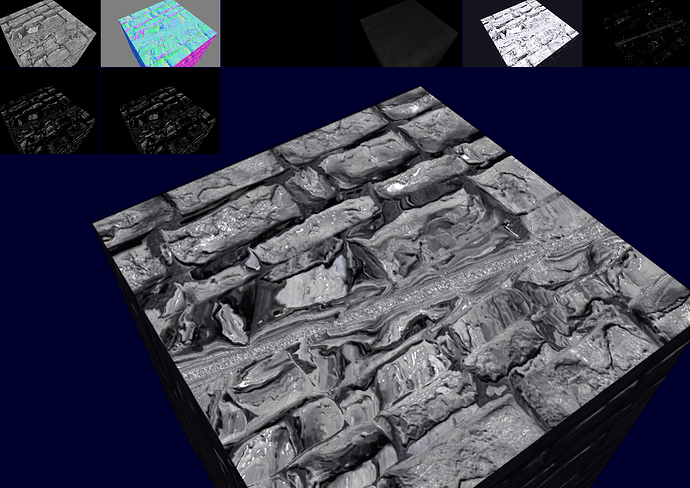GeonBit
September 22, 2018, 10:30pm
1
Hi all,
I tried to copy some shader code from the awesome deferred engine here:
float3 normalMap = GetNormalMap(input.TexCoord);
normalMap = normalize(mul(normalMap, worldSpace));
renderParams.Position = input.Position;
renderParams.Color = outputColor;
renderParams.Normal = normalMap;
renderParams.Depth = input.Depth;
renderParams.Metallic = Metallic;
renderParams.roughness = Roughness;
return WriteBuffers(renderParams);
}
PixelShaderOutput DrawBasic_PixelShader(DrawBasic_VSOut input)
{
Render_IN renderParams;
float4 outputColor = DiffuseColor; //* input.Color;
renderParams.Position = input.Position;
To add displacement to my own custom effects, but for some reason it doesn’t work and I just can’t figure out why…
VertexShaderOutput VertexShaderMain(VertexShaderInput input)
{
// Initialize Output
VertexShaderOutput output;
// Transform Position
float4 worldPosition = mul(input.Position, World);
float4 viewPosition = mul(worldPosition, View);
float4 fragPosition = mul(viewPosition, Projection);
output.Position = fragPosition;
output.FragPosition = fragPosition;
// Pass Depth
output.Depth.x = output.Position.z;
output.Depth.y = output.Position.w;
output.Depth.z = viewPosition.z;
// Build TBN Matrix (Tangent, Bitangent, Normals)
float3x3 TBN;
TBN[0] = normalize(mul(input.Tangent, (float3x3)WorldViewIT));
TBN[1] = normalize(mul(input.BiTangent, (float3x3)WorldViewIT));
TBN[2] = normalize(mul(input.Normal, (float3x3)WorldViewIT));
output.TBN = TBN;
// Pass UV
output.UV = TextureOffset + input.UV * TexturesTiling;
// Return Output
return output;
}
and here’s the part that do displacement in the pixel shader:
// get pixel height from depth map
float pixelHeight = tex2D(NormalSampler, UV).a;
// get tangent pos and tangent camera
float3 tangentPos = mul(input.FragPosition.xyz, input.TBN);
float3 tangentCamera = mul(CameraPosition, input.TBN);
// calculate view direction
float3 viewDir = normalize(tangentPos - tangentCamera);
// calculate new UV
float2 p = viewDir.xy / viewDir.z * pixelHeight * 0.01f;
UV = UV - p;
Which should do the same as the code from the deferred engine. However, the result I’m getting looks like this:
Where the distort line “moves” along the surface as I change the camera angle / position.
BTW before I tried this code I had the much more primitive displacement code:
float2 offset = EyeTangent.xy * (pixelHeight * 0.04f * DisplacementScale - 0.01f) + DisplacementBias;
return uv + offset;
Which was sort-of working but looks pretty ugly and basic.
@kosmonautgames hope you see this
Not sure on how @kosmonautgames does it, but here’s the depth-step calculation from my POM:
// n, t, b = tangent basis
// pointToCameraDirWS = normalize(cameraPos - pixelWorldPos)
float a = dot(n, -pointToCameraDirWS);
float3 s = float3(-dot(pointToCameraDirWS, t), dot(pointToCameraDirWS, b), a);
s *= -Depth / a * 0.1; // <--- pop-up not, sink down
float2 ds = s.xy; // <--- step direction
float d = HeightFieldRaycast(uv, ds); // finds distance along ds via linear + binary search
return uv + (ds * d);
GeonBit
September 23, 2018, 5:50am
3
Could you please post the content of ‘HeightFieldRaycast’?
Sure can:
float HeightFieldRaycast(float2 dp, float2 ds)
{
const int linearSteps = 10;
const int binarySteps = 10;
float size = 1.0 / float(linearSteps);
float depth = 0.0;
for (int i = 0; i < linearSteps; i++)
{
float t = tex2D(HeightMapSampler, dp + ds*depth).r;
if (depth < (1.0 - t))
depth += size;
}
for (int ii = 0; ii < binarySteps; ii++)
{
size *= 0.5;
float t = tex2D(HeightMapSampler, dp + ds * depth).r;
if (depth < (1.0 - t))
depth += (2.0 * size);
depth -= size;
}
return depth;
}
GeonBit
September 23, 2018, 5:59am
5
Thanks!
Correct, they’re the vectors from the vertex data.
The call to updateUv looks like:
return updateUV(pixelToEye, input.Normal, normalize(input.Tangent), normalize(input.Bitangent), 0.4, input.SampleUV);
GeonBit
September 23, 2018, 3:32pm
8
Will it be greedy to ask you to upload the whole effect file? I tried to add your method but it looks all distort and buggy and I’m beginning to think maybe I have a problem with the tangent calculation or something else…
Thanks!
No problem: https://gist.github.com/JSandusky/fdf97852fc9c84e35dd776f6a39998ab
Disp.inc is the file. See DoHeightMap in PBREffect.fx.
Edit: turns out I wasn’t using handed tangents here.
1 Like

